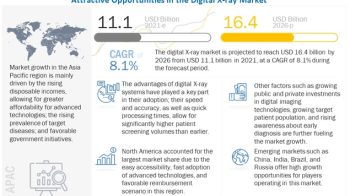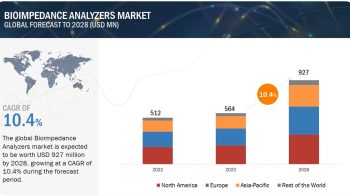The report “Environmental Monitoring Market is expected to reach USD 17.9 billion by 2026 from an estimated USD 14.5 billion in 2021, at a CAGR of 4.5% from 2021 to 2026.
An environmental monitoring system is used to analyze air, water, and soil samples and monitor the quality of the environment. This system controls and monitors the environmental state during and after an industrial operation. Market growth is mainly driven by the companies rearranging their operations and recovering from the COVID-19 impact, increasing public awareness about the health implications of environmental pollution, and rising levels of PM2.5 in the air. In addition, increasing government emphasis on compliance to pollution monitoring standards are expected to offer growth opportunities for players in the environmental monitoring market. However, issues related to high product costs and the limited usage of particulate analyzers in emerging and underdeveloped markets are expected to hinder the growth of the environmental monitoring market during the forecast period.
Download Report Brochure @https://www.marketsandmarkets.com/pdfdownloadNew.asp?id=216846315
Key Market Player:
The environmental monitoring market is dominated by Agilent Technologies (US), Danaher (US), Thermo Fisher Scientific (US), Shimadzu Corporation (Japan), PerkinElmer (US), 3M (US), Emerson Electric Co. (US), bioMérieux S.A. (France), Honeywell International Inc. (US), Merck KGaA (Germany), Siemens AG (Germany), Emerson Electric Co. (US), and Forbes Marshall (India).
Driver: Increasing need for efficient natural resource management
Natural resource management (NRM) refers to the sustainable utilization of major natural resources, such as land, water, air, minerals, forests, fisheries, and wild flora and fauna.
Most nations economies rely on natural resources for revenue generation, including material resources such as fossil fuels, metals, non-metallic minerals and biomass, water, and land. Using natural resources sustainably to increase their productivity and reduce the rate of depletion would be a win-win for the environment and economic growth.
Economies can become more resilient by reducing material dependence and adopting circular business models. Lower levels of material inputs cut waste flows and emissions, reduce risk factors affecting human health and well-being, and lower short-term production and consumption costs, as well as long-term societal costs. Sustainable management of resources in agriculture, forestry, fishing, mining, and quarrying can limit the environmental impacts of these industries and help mitigate climate change and biodiversity loss
Countries identified to have mega-biodiversity include Australia, the Democratic Republic of the Congo, Madagascar, South Africa, China, India, Indonesia, Malaysia, Papua New Guinea, Philippines, Brazil, Colombia, Ecuador, Mexico, Peru, United States, and Venezuela.
The Monitors segment accounted for the largest share of the environmental monitoring market, by product type.
Based on product type, the environmental monitoring market is segmented into monitors and software. The environmental monitors are further divided into indoor monitors, outdoor monitors, and portable monitors. The monitors segment accounted for 88.6% of the global environmental monitoring market, while outdoor environmental monitors segment group accounts for 44.1% of environmental monitors market. The large share of this market segment can be attributed to the increasing adoption of pollution monitoring strategies across industries.
The Continuous Monitoring segment accounted for the largest share of the environmental monitoring market, by sampling method.
Based on the sampling method, the environmental monitoring market is segmented into continuous, active, passive, and intermittent monitoring. The continuous monitoring segment accounted for the largest share of the environmental monitoring market with a share of 57.11%. The large share of this segment can primarily be attributed to the growing public emphasis on the development of environment-friendly industries, real-time monitoring of samples, and the rising levels of environmental pollution in major regions across the globe.
The Particulate Detection segment accounted for the largest share of the environmental monitoring market, by component.
Based on component, the environmental monitoring market is segmented into particulate detection, chemical detection, biological detection, temperature sensing, moisture detection, and noise measurement. The particulate detection is further divided into PM2.5 detection, PM10 detection and other detection, whereas the chemical detection is further segmented into gas detection, volatile organic compound detection, pesticide detection and other chemicals. The particulate detection segment accounted for the largest share of 47.2% of the environmental monitoring market in 2020. This can be attributed to the rising levels of PM2.5 and PM10 in the air, increasing market demand for outdoor and indoor air quality monitors or PM monitors, and rapid rise in air pollution levels due to increasing industrialization and urbanization in the emerging countries.
Request 10% Customization: https://www.marketsandmarkets.com/requestCustomizationNew.asp?id=216846315
The Asia Pacific market is expected to grow at the highest CAGR during the forecast period
The environmental monitoring market has been segmented into five major regions, namely, North America, Europe, the Asia Pacific, Latin America, and the Middle East & Africa. North America accounted for the largest share of 50.6% of the environmental monitoring market, followed by Europe with a share of 25.5%. On the other hand, the Asia Pacific market is estimated to register the highest growth rate during the forecast period. This can primarily be attributed to the increase in government funding for the establishment of environmental monitoring stations, stringent regulations that support the greater adoption of pollution monitoring technologies, and technological advancements in the field of environmental sensors.
Report Link: Environmental Monitoring Market
The growing emphasis of key players on emerging markets in this region, new product launches, and increasing focus on supplier contracts are further fueling the growth of the environmental monitoring market in the Asia Pacific. However, factors such as limited accessibility of environmental monitoring during emergencies and a dearth of trained and skilled technicians in developing Asia Pacific countries hamper the demand for environmental monitoring in this region.
Table of Content:
- INTRODUCTION (Page No. – 26)
- OBJECTIVES OF THE STUDY
- MARKET DEFINITION
- MARKET SCOPE
- CURRENCY USED FOR THE STUDY
- KEY MARKET STAKEHOLDERS
- RESEARCH METHODOLOGY (Page No. – 30)
- RESEARCH DATA
- MARKET SIZE ESTIMATION METHODOLOGY
- MARKET SIZE ESTIMATION
- EXECUTIVE SUMMARY (Page No. – 39)
- PREMIUM INSIGHTS (Page No. – 44)
- MARKET OVERVIEW (Page No. – 49)
- ENVIRONMENTAL MONITORING MARKET, BY PRODUCT (Page No. – 70)
- INTRODUCTION
- MONITORS
- SOFTWARE
- ENVIRONMENTAL MONITORING MARKET, BY SAMPLING METHOD (Page No. – 95)
- ENVIRONMENTAL MONITORING MARKET, BY COMPONENT (Page No. – 101)
- ENVIRONMENTAL MONITORING MARKET, BY APPLICATION (Page No. – 117)
Contact:
Mr. Aashish Mehra
MarketsandMarkets™ INC
630 Dundee Road
Suite 430
Northbrook, IL 60062
USA: +1-888-600-6441
Email: sales@marketsandmarkets.com
Visit Our Website: https://www.marketsandmarkets.com
About MarketsandMarkets™
MarketsandMarkets™ is a blue ocean alternative in growth consulting and program management, leveraging a man-machine offering to drive supernormal growth for progressive organizations in the B2B space. We have the widest lens on emerging technologies, making us proficient in co-creating supernormal growth for clients.
The B2B economy is witnessing the emergence of $25 trillion of new revenue streams that are substituting existing revenue streams in this decade alone. We work with clients on growth programs, helping them monetize this $25 trillion opportunity through our service lines – TAM Expansion, Go-to-Market (GTM) Strategy to Execution, Market Share Gain, Account Enablement, and Thought Leadership Marketing.
Built on the ‘GIVE Growth’ principle, we work with several Forbes Global 2000 B2B companies – helping them stay relevant in a disruptive ecosystem. Our insights and strategies are moulded by our industry experts, cutting-edge AI-powered Market Intelligence Cloud, and years of research. The KnowledgeStore™ (our Market Intelligence Cloud) integrates our research, facilitates an analysis of interconnections through a set of applications, helping clients look at the entire ecosystem and understand the revenue shifts happening in their industry.
To find out more, visit MarketsandMarkets™ or follow us on Twitter, LinkedIn and Facebook.

